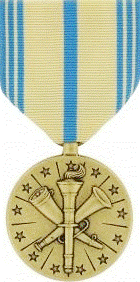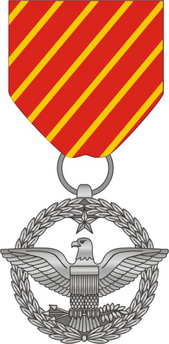The Commendation Medal is a mid-level United States military decoration presented for sustained acts of heroism or meritorious service. Each branch of the United States Armed Forces issues its own version of the Commendation Medal, with a fifth version existing for acts of joint military service performed under the Department of Defense.
The National Defense Service Medal (NDSM) is a service award of the United States Armed Forces established by President Dwight D. Eisenhower in 1953. It is awarded to every member of the US Armed Forces who has served during any one of four specified periods of armed conflict or national emergency from 1950 to the present. Combat or "in theater" service is not a requirement for the award.
A Sea Service Ribbon is an award of the United States Navy, U.S. Marine Corps, U.S. Coast Guard, the U.S. Army, and the NOAA Commissioned Officer Corps which recognizes those service members who have performed military duty while stationed on a United States Navy, Coast Guard, Army, or NOAA vessel at sea and/or members of the Navy, Marine Corps or Coast Guard who have been forward-deployed with their home unit.
The Air Force Training Ribbon is the lowest military award of the United States Air Force, ranking only above foreign military awards.
The Army Service Ribbon (ASR) is a military award of the United States Army that was established by the Secretary of the Army on 10 April 1981 as announced in Department of the Army General Order 15, dated 10 October 1990.
The Vietnam Service Medal is a military award of the United States Armed Forces established on 8 July 1965 by order of President Lyndon B. Johnson. The medal is awarded to recognize service during the Vietnam War by all members of the U.S. Armed Forces provided they meet the award requirements.
A "V" device is a metal 1⁄4-inch (6.4 mm) capital letter "V" with serifs which, when worn on certain decorations awarded by the United States Armed Forces, distinguishes an award for heroism or valor in combat instead of for meritorious service or achievement.
A Noncommissioned Officer Professional Development Ribbon is an award presented by the United States Army and Air Force to recognize those noncommissioned officers who have completed a prescribed leadership course at an NCO training school. The Navy, Marine Corps, and Coast Guard have no equivalent to the Noncommissioned Officer Development Ribbon.

The Good Conduct Medal is one of the oldest military awards of the United States Armed Forces. The U.S. Navy's variant of the Good Conduct Medal was established in 1869, the Marine Corps version in 1896, the Coast Guard version in 1923, the Army version in 1941, and the Air Force version in 1963; the Air Force Good Conduct Medal was temporarily discontinued from February 2006 to February 2009, followed by its subsequent reinstatement.
An Overseas Service Ribbon is a service military award of the United States military which recognizes those service members who have performed military tours of outside the borders of the United States of America. There are different versions of the Overseas Service Ribbons for the U.S. Army, U.S. Navy, U.S. Air Force, and the U.S. Coast Guard. Both the U.S. Navy and the U.S. Marines receive the Navy and Marine Corps Overseas Service Ribbon.
The Air Force Organizational Excellence Award is a unit award of the United States Air Force created by the Secretary of the Air Force on 26 August 1969. The award is presented to Air Force internal organizations that are entities within larger organizations. Examples of eligible organizations are MAJCOM headquarters, Field Operating Agencies, Direct Reporting Units, and other unique unnumbered organizations.

A Reserve Good Conduct Medal refers to any one of the five military conduct awards, four of which are currently issued and one of which was previously issued, by the United States Armed Forces to enlisted members of the Reserve and National Guard. The primary difference between the regular Good Conduct Medal and the Reserve Good Conduct Medal is that the regular Good Conduct Medal is only issued for active duty service while the reserve equivalent is bestowed for reserve duties such as drills, annual training, and additional active duty for either training or operational support to the active duty force or, in the case of the Army National Guard and Air National Guard, in support of Title 32 U.S.C. state active duty (SAD) such as disaster response and relief.

The Armed Forces Reserve Medal (AFRM) is a service medal of the United States Armed Forces that has existed since 1950. The medal recognizes service performed by members of the reserve components and is awarded to both officers and enlisted personnel. The medal is considered a successor award to the Naval Reserve Medal and the Marine Corps Reserve Ribbon, which were discontinued in 1958 and 1967, respectively.

The Recruiter Badge is a decoration of the United States uniformed services that is awarded to personnel who have performed recruitment duties as service recruiters. The Recruiter Badge is issued by every branch of the U.S. uniform services except for the U.S. Marine Corps and the NOAA Commissioned Corps. With the exception of the U.S. Army, a Recruiting Service Ribbon is also awarded to those personnel who have completed successful tours as uniform service recruiters.
The Outstanding Airman of the Year Ribbon is a military award of the United States Air Force which was created on February 21, 1968 by order of Secretary of the Air Force Harold Brown. The first presentation of the award was in June 1970. The Outstanding Airman of the Year Ribbon is the highest personal ribbon award of the United States Air Force.
The Basic Training Honor Graduate Ribbon is the informal collective name for three equivalent United States military awards for the Navy, Air Force, and Coast Guard recruits who graduate at the top of their basic training classes: The Air Force Basic Military Training Honor Graduate Ribbon, the Coast Guard Basic Training Honor Graduate Ribbon, and the Navy Recruit Honor Graduate Ribbon.
The Recruiting Service Ribbon is a military award of the United States Armed Forces which is issued by every branch of service with the exception of the United States Army. The Recruiting Service Ribbon recognizes those military service members who have completed a successful tour as a military recruiter in one of the United States Military Recruiting Commands.

The Air Force Combat Action Medal (AFCAM) is decoration of the United States Air Force and United States Space Force to recognize airmen and guardians for active participation in ground or air combat.

The Nuclear Deterrence Operations Service Medal is a service medal of the United States Air Force established on 27 May 2014. The medal recognizes service by personnel in various career fields who have served in units involved with national strategic nuclear deterrence operations. Officer and enlisted personnel in the Active, Air Force Reserve, and Air National Guard communities are eligible for this medal. Eligible service is retroactive from 26 December 1991.
The Air Force Special Duty Ribbon is a ribbon that is only awarded by the United States Air Force. Established 4 September 2014 by the Secretary of the Air Force,






